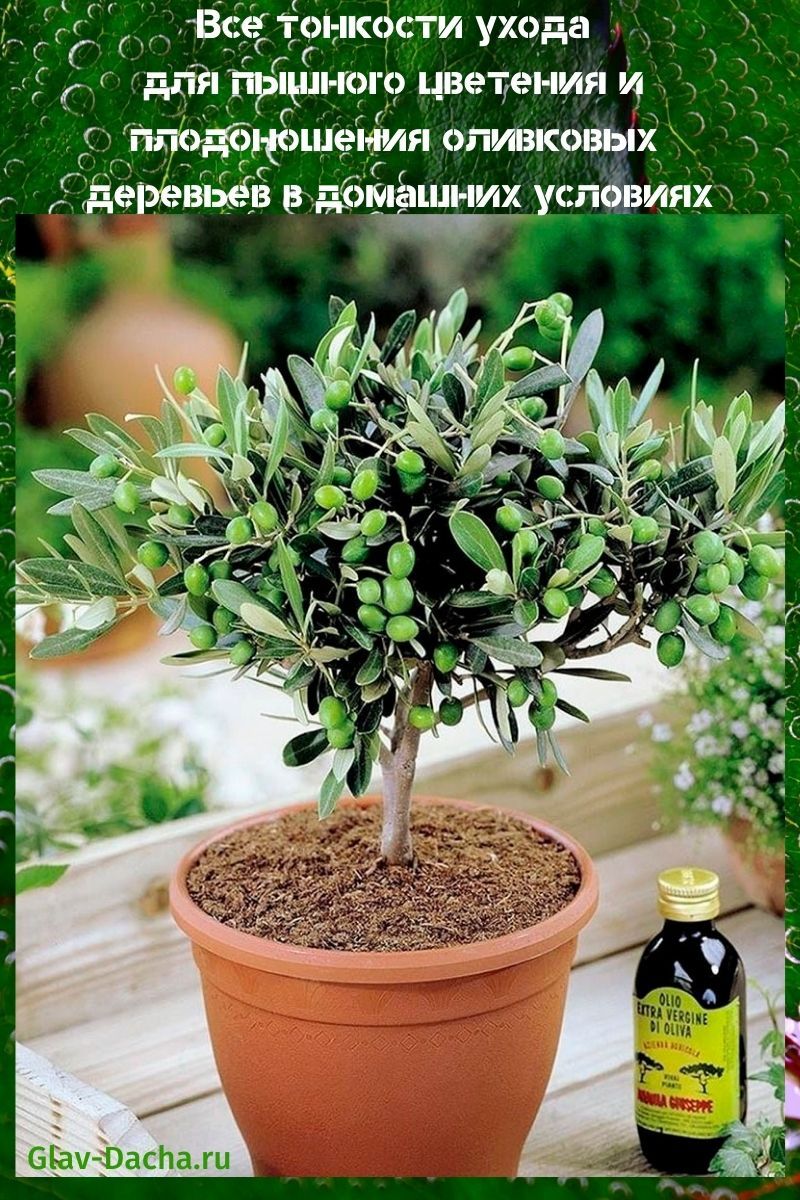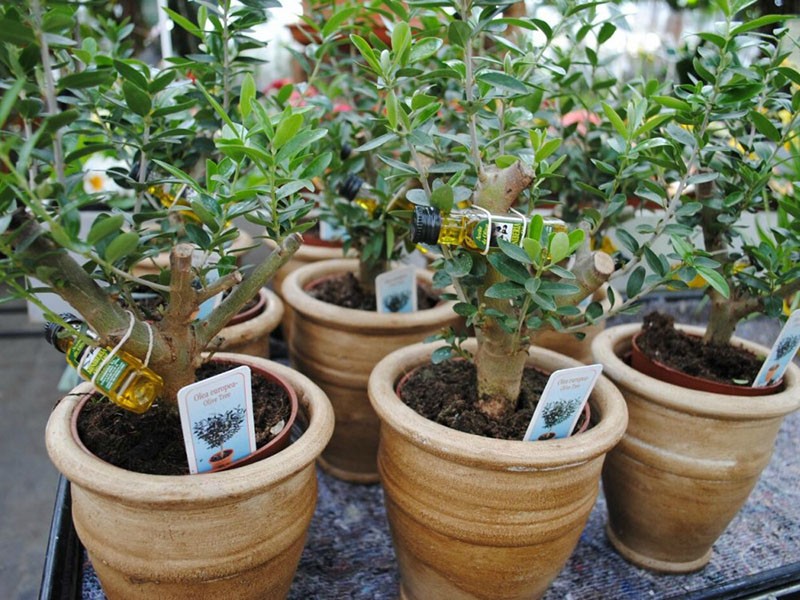All the details of care for the lush flowering and fruiting of olive trees at home
 The olive tree (olea europaea) is one of the oldest plants on the planet, because the first mentions of it can be found in biblical writings and ancient Greek myths. Today it is included in the list of the most popular exotic plants - many growers gladly grow olive trees at home. Oliva cannot be called unpretentious, but if you provide it with the right, competent care, you can get an exotic interior decoration with fragrant inflorescences and healthy fruits.
The olive tree (olea europaea) is one of the oldest plants on the planet, because the first mentions of it can be found in biblical writings and ancient Greek myths. Today it is included in the list of the most popular exotic plants - many growers gladly grow olive trees at home. Oliva cannot be called unpretentious, but if you provide it with the right, competent care, you can get an exotic interior decoration with fragrant inflorescences and healthy fruits.
Olive trees at home - care rules

Caring for an olive tree at home consists of regular watering, feeding, pruning and replanting the plant. Also, we must not forget about the prevention of infection with diseases and pests and the fight against existing problems.
Lighting and location
 An indoor olive tree will only actively grow, develop and bear fruit in bright light conditions. In winter, the plant should be placed on a well-lit windowsill or use additional light sources.
An indoor olive tree will only actively grow, develop and bear fruit in bright light conditions. In winter, the plant should be placed on a well-lit windowsill or use additional light sources.
In summer, it is advisable to take a pot with a tree to a balcony or terrace, preferably from the south side of the building. The olive tree should not be left in the shade, as this will slow down its growth.
The olive tree can be grown as an ordinary tub plant - kept in the fresh air from spring until the first frost, and then transferred to the room for the winter.
Temperature and humidity
 When caring for an olive tree at home, it is very important to provide it with comfortable temperature conditions. The plant tolerates the summer heat well, so it can be both outdoors and indoors.
When caring for an olive tree at home, it is very important to provide it with comfortable temperature conditions. The plant tolerates the summer heat well, so it can be both outdoors and indoors.
For wintering, the olive tree must be moved indoors or onto the balcony. Optimum temperature conditions are from + 5 ° С to + 10 ° С. It is best to leave the pot with a tree on the glazed balcony - this way it will receive the necessary sunlight and air flow.
In terms of air humidity, the olive is unpretentious. She has enough natural humidity - in the summer in the fresh air, in the winter on the balcony or in the greenhouse.
If a pot with an olive tree is located in a room with the heating turned on, its leaves must be sprayed with a spray bottle twice a day.
Watering
 Under natural conditions, olive trees are drought tolerant and adaptable to almost any environmental conditions. Their trunks are capable of absorbing the required amount of moisture.
Under natural conditions, olive trees are drought tolerant and adaptable to almost any environmental conditions. Their trunks are capable of absorbing the required amount of moisture.
When caring for a European olive at home, you need to take into account that this plant tolerates a short-term moisture deficit well, but a prolonged drought is destructive for it. Young olives need regular watering, otherwise their growth will slow down.
When caring for mature olive trees, you need to monitor the condition of the soil and water only as it dries. It is best to water the tree abundantly, leave it for a while and drain the excess moisture from the pallet. This should be done no more than 1-2 times a week.
Excess moisture is more detrimental to the olive than lack of it. As a result, the leaves of the olive tree begin to become covered with brown-brown spots, wither and crumble.
In winter, the plant is dormant - at this time, watering should be reduced as much as possible.
Sprinkling is beneficial for the olive tree. This procedure is necessary for the plant in hot summer. Sprinkling is best done once a week, but if the olive is in a cool place, you can skip this procedure.
Top dressing

For full development, the olive tree needs nutrients - nitrogen, potassium, phosphorus:
- To do this, at the end of March or April, the plant is fed with organic or complex mineral fertilizers, which include nitrogen. Top dressing should be applied at least 2 times a month.
- In the summer season, the olive tree is fertilized with complex liquid formulations containing phosphorus and potassium. Top dressing can be applied both under the root and foliar method. Solution gives a good effect succinic acidsprayed with olive branches and leaves.
Pruning
 When growing an olive tree, thinning pruning should be carried out every year to form a neat and well-groomed crown. During pruning, all weakened and diseased shoots are removed, as well as those that grow inward and thicken the crown.
When growing an olive tree, thinning pruning should be carried out every year to form a neat and well-groomed crown. During pruning, all weakened and diseased shoots are removed, as well as those that grow inward and thicken the crown.
 Most often, the teething procedure is carried out simultaneously with the forming one. During formative pruning, first of all, it is necessary to remove old shoots more than 2-3 years old, since only last year's branches can bear fruit.
Most often, the teething procedure is carried out simultaneously with the forming one. During formative pruning, first of all, it is necessary to remove old shoots more than 2-3 years old, since only last year's branches can bear fruit.
 The best option for an indoor olive tree is a spherical crown shape. It not only looks neat and impressive, but also simplifies plant care. Pruning is done with a regular garden pruner. All cut points must be treated with garden varnish to prevent the penetration of infection.
The best option for an indoor olive tree is a spherical crown shape. It not only looks neat and impressive, but also simplifies plant care. Pruning is done with a regular garden pruner. All cut points must be treated with garden varnish to prevent the penetration of infection.
If flowering does not matter, pruning can be done at any time of the year. To get lush flowering, you need to abandon spring pruning.
Transfer
 With age, the olive tree needs replanting. Its root system is expanding and requires a larger container. Depending on the growth rate of the olive, pruning is carried out every 2-4 years.
With age, the olive tree needs replanting. Its root system is expanding and requires a larger container. Depending on the growth rate of the olive, pruning is carried out every 2-4 years.
To transplant an olive tree, you need to choose a pot whose diameter is about 4-6 cm larger than the previous container. It should be clay - this material allows air to pass through and allows the plant's root system to "breathe".
The procedure is carried out by transshipment of an earthy lump. It is imperative to fill the drainage layer at the bottom of the container. It can be from broken brick, fine gravel or expanded clay 3-4 cm thick. It will prevent stagnation of moisture in the soil.
Blooming olive trees at home

While olive trees are blooming at home, it is important to follow a few rules to ensure fruit set.:
- Moistening and sprinkling the plant is carried out only after the top layer of the soil has dried. In this case, you need to water abundantly, to the bottom of the pot, and then drain excess water from the pan.
- A blooming olive tree needs a long day of light - it should be at least 13-15 hours. In cloudy weather, it can be placed under a phytolamp.
- Do not rely on self-pollination - the grower needs to "help" the plant to set fruit. To do this, shake the twigs slightly so that the pollen falls on the neighboring inflorescences. For reliability, you can use a small brush and transfer the pollen by hand. This is a time consuming but rewarding process.
Caring for an olive tree at home has several characteristics. It requires a comfortable environment for the plant.:
- correct temperature and humidity;
- sufficient lighting;
- timely watering and feeding.
 Subject to these nuances, you can grow a lush flowering tree, which can become an exotic decoration for any room.
Subject to these nuances, you can grow a lush flowering tree, which can become an exotic decoration for any room.